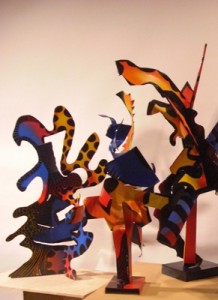Press
Judd Tully
Richard Pitts—Kandy Colored Tangerine Flake Baby
Long attuned to the time honored mediums of oil on canvas, wood cuts and carved or otherwise fabricated wood sculptures, Richard Pitts has turned a sharp corner in his color-charged oeuvre with a decidedly new body of work devoted to steel.
Ranging in size from relatively modest table top sculptures to taller, totem-scaled free-standing works, the unifying theme is hand-made, hand cut and manipulated forms that emerge from single sheets of steel or aluminum.
Though unquestionably abstract, the compositions that emerge tend to have distinctive references to the natural world of vibrantly colored birds, fish and insects, a kind of plunge into wild habitats untrammeled by concrete or the high-decibel distractions of urban life.
The immediacy of the painted forms, the choreographed impression of feathers, fins and tendrils that animate the works, also allow the viewer to decompress, slow down and embrace the sensual aerie of objects.
Pushing that thought further, the experience of looking at the new work is something like a meditative walk by a field or marshy inlet and the chance sighting, however fleeting, say of a blue crab swimming underwater, leaving just a flash of bright orange color from her extended claws.
At the same time, another viewer might see a connection to an Art Deco objet from the 1920’s, bristling with exotic and stylized materials, and flaunting elaborately complex patinas borrowed from Japanese craftsmen or the surfaces from 1960’s custom car, hot rod culture epitomized by Tom Wolfe in his classic non-fiction book, The Kandy-Kolored Tangerine-Flake Streamline Baby.
There is nothing static about the cut, bended, curly-cued and folded forms, especially as you encounter each work in the round, as if they were moving on a carousel and begin to take in their own three-dimensional quirks that stray well-beyond an isolated frontal or side view.
One side of a curvy formed tendril might reveal a hothouse color of lemon yellow while the other a more cool tone of royal blue, as if a shaft of sun or moon light influenced the impression.
The artist’s seemingly effortless ability to manipulate the steel as if the tensile strength of the material was paper or the discipline employed to conquer it something like Origami, further accentuates the direct experience of seeing something fresh and lively.
Deliberately unlike the heavy metal feats of American 20th century, Post-War sculptors such as David Smith and Mark di Suvero, Pitts pursues a more gymnastic, light on your feet program, difficult to pigeon-hole and dangerous to park in a simply decorative category.
The sculptures are more sophisticated and dynamic than mere eye candy, since they also bristle with formal attributes and seamlessly brandish the welded and cut skills that Smith & Company established on the brawny legs of Abstract Expressionism.
The Vulcan like melding of steel and color in these assemblage-styled works enables Pitts to establish his own vocabulary and imprint the works with stunning patterns that in ways mime Nature’s own motifs.
by Judd Tully
New York City
April 2009
